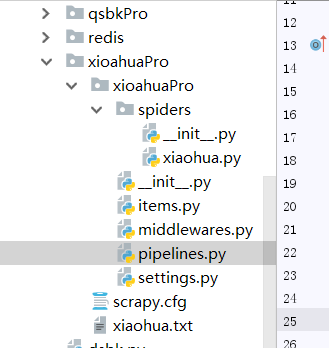我们在pycharm上爬取
首先我们可以在本文件打开命令框或在Terminal下创建
scrapy startproject xiaohuaPro ------------创建文件

scrapy genspider xiaohua www.xxx.com ----------创建执行文件
一.首先我们要进行数据的爬取
import scrapy from xioahuaPro.items import XioahuaproItem class XiaohuaSpider(scrapy.Spider): name = 'xiaohua' start_urls=['http://www.521609.com/daxuemeinv/'] #生成一个通用的url模板 url = 'http://www.521609.com/daxuemeinv/list8%d.html' pageNum =1 def parse(self, response): li_list=response.xpath('//div[@class="index_img list_center"]/ul/li') for li in li_list: name = li.xpath('./a[2]/text() | ./a[2]/b/text()').extract_first() img_url = 'http://www.521609.com'+li.xpath('./a[1]/img/@src').extract_first() #实例化一个item类型的对象 item = XioahuaproItem() item['name'] = name item['img_url'] = img_url #item提交给管道 yield item # 对其他页码的url进行手动i请求的发送 if self.pageNum <= 24: ------爬取的页数 self.pageNum += 1 new_url = format(self.url%self.pageNum) yield scrapy.Request(url=new_url,callback=self.parse)
之后再items.py文件下为item对象设置属性
将爬取到的所有信息全部设置为item的属性
# -*- coding: utf-8 -*- # Define here the models for your scraped items # # See documentation in: # https://doc.scrapy.org/en/latest/topics/items.html import scrapy class XioahuaproItem(scrapy.Item): # define the fields for your item here like: name = scrapy.Field() img_url = scrapy.Field()
二.写入pipelines.py内容
首先写入到自定义的文件里去
作用:将解析到的数据存储到某一个平台中。 import pymysql from redis import Redis class XioahuaproPipeline(object): fp = None def open_spider(self,spider): print('开始爬虫!') self.fp = open('./xiaohua.txt','w',encoding='utf-8') #作用:实现持久化存储的操作 #该方法的item参数就可以接收爬虫文件提交过来的item对象 #该方法每接收一个item就会被调用一次(调用多次) def process_item(self, item, spider): name = item['name'] img_url = item['img_url'] self.fp.write(name+':'+img_url+' ') #返回值的作用:就是将item传递给下一个即将被执行的管道类 return item # def close_spider(self,spider): print('结束爬虫!') self.fp.close() #
写到数据库里面,我们要在数据库里面创建个表(将mysql和redis都启动)
class MysqlPipeline(object): conn = None cursor = None def open_spider(self, spider): #解决数据库字段无法存储中文处理:alter table tableName convert to charset utf8; self.conn = pymysql.Connect(host='127.0.0.1',port=3306,user='root',password='123',db='test',charset='utf8') print(self.conn) def process_item(self, item, spider): self.cursor = self.conn.cursor() try: self.cursor.execute('insert into xiaohua values ("%s","%s")'%(item['name'],item['img_url'])) self.conn.commit() except Exception as e: print(e) self.conn.rollback() return item def close_spider(self, spider): self.cursor.close() self.conn.close()
在相同的文件下创建redis类写入数据
class RedisPipeline(object): conn = None def open_spider(self, spider): self.conn = Redis(host='127.0.0.1',port=6379) print(self.conn) def process_item(self, item, spider): dic = { 'name':item['name'], 'img_url':item['img_url'] } print(str(dic)) self.conn.lpush('xiaohua',str(dic)) return item def close_spider(self, spider): pass
三.更改配置文件,在settings.py里面
#添加上这行代码
USER_AGENT = 'Mozilla/5.0 (Windows NT 6.1; Win64; x64) AppleWebKit/537.36 (KHTML, like Gecko) Chrome/73.0.3683.86 Safari/537.36' # Obey robots.txt rules ROBOTSTXT_OBEY = False -----改成False
ITEM_PIPELINES = { 'xioahuaPro.pipelines.XioahuaproPipeline': 300, ---对应文件 # 'xioahuaPro.pipelines.MysqlPipeline': 301, ----对应数据库
# 'xioahuaPro.pipelines.RedisPipeline': 302, -----对应redis } LOG_LEVEL = 'ERROR'
# CRITICAL --严重错误
#ERROR ---一般错误
#WARNING ---警告信息
#INFO ---一般信息
#DEBUG --调试信息
然后我们在终端去指定爬虫程序
scrapy crawl 名字(name对应的值)